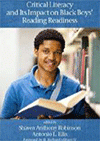
Critical Literacy and Its Impact on Black Boys’ Reading Readiness
Edited by:
Shawn Anthony Robinson, University of Wisconsin-Madison
Antonio L. Ellis, American University
Published 2023
Academic success for African American boys’ in Special Education is frequently elusive as the United States continues to endure the legacy of academic discrimination (Blanchett, 2010; Skiba et al., 2008). Consequently, educational policies have not fully protected the equal rights or adequately responded to the learning needs of students’ academic shortcomings or taken advantage of their strengths (Parkinson & Rowan, 2008; Tatum, 2005). This persistent reading gap has not closed in generations, which is deeply harmful to our American democracy (Wolf, 2019). With every passing year that goes by without alleviating problems affecting the reading gap, the damage is costly, and no failure is more expensive than the failure to educate African American males in the PK-12 pipeline (Robinson & Thompson 2019). The danger to our students becomes more critical each year, and these are problems that are deeply rooted in America. And, while teachers cannot change the past, we can, and must, change the special education system that shapes the future of students. Thus, a reader’s identity becomes shaped by the intersection of factors that are both inherent and neurologically based, and factors that arise as a result of one’s home and academic environment (Hoyles & Hoyles, 2010; Robinson, Ford, Ellis, & Hartlep, 2016; Wolf, 2007). Reading instruction must be culturally relevant which can strengthen the reader’s identity and capacity for critical thinking (Arya & Feathers, 2012; Flowers, 2007; Robinson, 2017). Critical literacy is grounded in the sociocultural perspective and way of thinking about curriculum, literacies, and honoring students’ lived experiences, especially within the contexts of Special Education (Brooks, 2006; Gay, 2002; Norman, 2011).
This edited book will fill a needed gap in scholarly research, as manuscripts adopts a critical analysis that brings together the latest theoretical, conceptual, quantitative, qualitative, and mixed methods research studies. Chapters will have clear and explicit implications for educational practice and make a significant contribution to the field of special education and reading instruction.
CONTENTS
Foreword, H. Richard Milner IV. Prelude—We Are Left Out: Literacy for Black Boys, Antonio L. Ellis, Shawn Anthony Robinson, and Gary Hamilton. Acknowledgments, Let the Schoolhouse Say, Amen: The Pedagogical Congruency Between the Black Church and Critical Literacy, Marc Antoine Lavarin. Teaching Critical Literacy: Models for Implementing Instruction in All Grade Levels, Casey Medlock Paul. Representation of Afrocentric Superheroes and Building a Reader Identity Through Graphic Novels, Shawn Anthony Robinson and Antonio L. Ellis. Was Blind but Now I See: Addressing Blind Spots in Literacy Instruction to Promote Healthy Self-Concepts, Walter Lee. Starting Young: Emergent Black Masculinity and Early Literacy, Alma Stevenson and Sabrina Ross. Do You Know How to Teach Me? Augmenting the Knowledge of Educators to Address the Literacy Needs of Students With Intellectual Disabilities, Aimeé Cepeda. The Role of School Leaders in Increasing Access to Literacy Interventions, Shareen Feranders and Sarah Irvine Belson. Afterword, Richard C. McGregory, Jr. About the Editors. About the Contributors.
-
Paperback979-8-88730-193-8
Web price: $45.04 (Reg. 52.99)
-
Hardcover979-8-88730-194-5
Web price: $80.74 (Reg. 94.99)
- eBook979-8-88730-195-2

- LAN010000 - LANGUAGE ARTS & DISCIPLINES: Literacy
- LAN013000 - LANGUAGE ARTS & DISCIPLINES: Reading Skills
- EDU054000 - EDUCATION: Urban
-
 Economic, Political and Legal Solutions to Critical Issues in Urban Education and Implications for Teacher Preparation
Economic, Political and Legal Solutions to Critical Issues in Urban Education and Implications for Teacher Preparation
-
 Effects of Government Mandates and Policies on Public Education in Africa, the Caribbean, and the Middle East
Effects of Government Mandates and Policies on Public Education in Africa, the Caribbean, and the Middle East
-
 Homeschooling Black Children in the U.S.
Theory, Practice, and Popular Culture
Homeschooling Black Children in the U.S.
Theory, Practice, and Popular Culture
-
 Modern Heroics
How HBCUs Navigated the COVID-19 Pandemic
Modern Heroics
How HBCUs Navigated the COVID-19 Pandemic
-
 Racism by Another Name
Black Students, Overrepresentation, and the Carceral State of Special Education
Racism by Another Name
Black Students, Overrepresentation, and the Carceral State of Special Education
-
 Un-Silencing Youth Trauma
Transformative School-Based Strategies for Students Exposed to Violence & Adversity
Un-Silencing Youth Trauma
Transformative School-Based Strategies for Students Exposed to Violence & Adversity
-
 Working While Black
The Untold Stories of Student Affairs Practitioners
Working While Black
The Untold Stories of Student Affairs Practitioners

